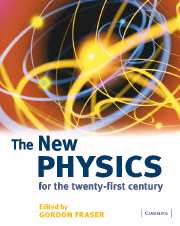Book contents
- Frontmatter
- Contents
- Contributors
- Editor’s acknowledgements
- Introduction: The new physics for the Twenty-First Century
- I Matter and the Universe
- II Quantum matter
- III Quanta in action
- IV Calculation and computation
- V Science in action
- 16 Biophysics and biomolecular materials
- 17 Medical physics
- 18 Physics of materials
- 19 Physics and Society
- Index
- References
17 - Medical physics
Published online by Cambridge University Press: 05 June 2014
- Frontmatter
- Contents
- Contributors
- Editor’s acknowledgements
- Introduction: The new physics for the Twenty-First Century
- I Matter and the Universe
- II Quantum matter
- III Quanta in action
- IV Calculation and computation
- V Science in action
- 16 Biophysics and biomolecular materials
- 17 Medical physics
- 18 Physics of materials
- 19 Physics and Society
- Index
- References
Summary
Introduction
Physics ultimately rules the processes in living organisms and thus is in that sense fundamental for understanding medicine. To cite some examples involving different branches of physics:
the dynamics of forces in joints, e.g. the dependence of stress in an articulation → mechanics
the microstructure of bones and the role of compounds with high elasticity and high tensile strength → solid-state physics of articulations
control of blood circulation and the variable viscosity of blood and blood plasma → hydrodynamics
passive molecular transport through membranes via osmosis → thermodynamics
signal conduction in nerve cells → electrodynamics
image formation on the retina → optics and
hearing → acoustics and mechanics.
Many physical properties of tissues, substances, cells, and molecules and of their mechanisms of operation are exploited for diagnostics and therapy (e.g. ultrasonic imaging, electro- or magneto-encephalography, high-frequency electromagnetic-radiation therapy). Rather than these manifold relationships between physics and the phenomena of medicine and biology, medical physics today covers that part of physics in which new phenomema are exploited and new techniques developed explicitly for use in diagnostics and treatment. The largest area has to do with diagnostic methods, the most prominent being transmission radiography with X-rays, which was introduced soon after the discovery of X-rays by Röntgen in 1895. Many sections of this chapter cover the principles and recent developments of diagnostic tools, weighing their virtues as well as possible disadvantages (e.g. adverse side effects). The various techniques also provide complementary information.
- Type
- Chapter
- Information
- The New PhysicsFor the Twenty-First Century, pp. 444 - 480Publisher: Cambridge University PressPrint publication year: 2006

